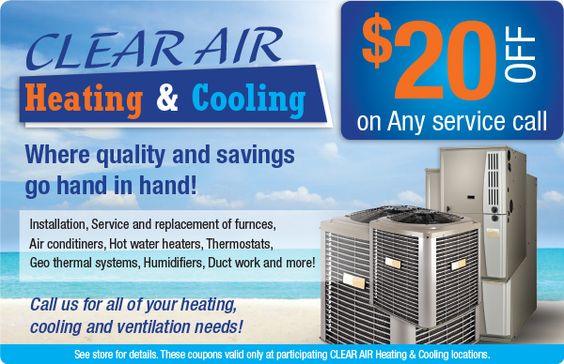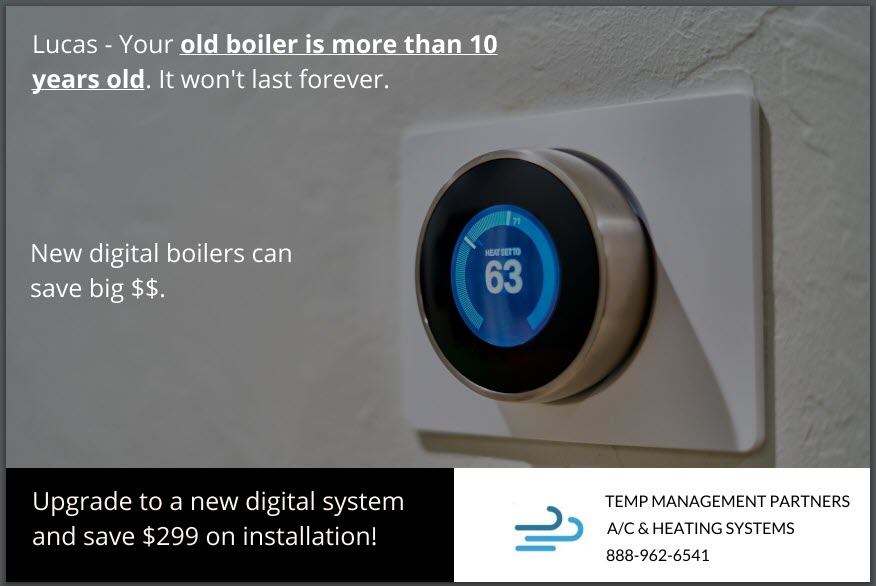Sending direct mail HVAC postcards can help you find new prospects, nurture existing leads – and cut your marketing costs. New automation tools make it fast and easy.

When the weather is cool, nobody is thinking about their AC systems. Likewise, when the weather is hot, furnace maintenance is the last thing on the mind of the average homeowner.
Then that first sweltering hot spell of summer or freezing cold spell of winter kicks in, and your phones start ringing off the hook. That surge of new business is great, but the most successful HVAC contactors prefer a steady stream of jobs – a consistent flow of new leads along with existing customers requesting maintenance, regardless of the season.
This is where a targeted strategy that’s automatically executed based on your marketing plan can help you grow your business without the stress of those seasonal ups and downs.
Direct mail postcards can be an excellent way to find new leads, keep in touch with prospects, and maximize the lifetime value of each customer so you can generate long-term revenues for years to come.
HVAC Postcards: The Marketing Workhorse
Why HVAC postcards? Because they work – and work well. I know it’s tempting to rely on your website, online advertising, and email as primary marketing tools. After all, sending emails costs just pennies. But every year consumers are bombarded with more and more emails. You’re lucky if people even glance at the subject line. How many emails do you delete without reading them – even if it’s a company you do business with?
But everyone needs to look through their mail every day. It’s pretty much a daily ritual. You have to at least glance at each mailing if only to make sure it’s addressed to you. That’s what makes direct mail such a lucrative marketing tool, especially for HVAC contractors. Sure it costs a lot more than online advertising, but the returns are well worth the extra cost. If that weren’t true, why would so many HVAC postcards like these arrive in so many mailboxes?

Even if you send a postcard to a prospect who has no immediate need, there’s a good chance they’ll hold onto it, sometimes for weeks or months. Hardly anyone saves an email if there’s no immediate need.
Direct mail makes a much better impression, but that cost per impression can be high. That makes it essential to understand what works, what doesn’t, and why.
Many HVAC businesses rely on direct mail because it’s so easy to target prospects and customers far more precisely than using online media alone. In some cases, postcards are designed to generate leads. Other postcards are sent to prospects who’ve already responded and have called or visited your website to complete a form. And other postcards can be sent to customers you’ve already done business with to help gain even more revenue from customers who already know you.
By testing postcards in your local market, you can easily generate a great return on investment. Here are some tips for using HVAC postcards at each stage of your sales cycle. Let’s start with lead generation, prospecting for new leads.
HVAC postcards: an excellent lead generation strategy
Lead generation postcards are a mainstay for savvy HVAC marketers. What separates the winners from the losers? There are some consistent attributes associated with top performers.

For years, successful direct mail marketers have followed what’s known as the “40-40-20” rule. That’s a principle that acknowledges that the success of a direct mail program is based 40% on the offer, 40% on the list you use, and 20% on the copy and design of your mailing.
Let’s look at each of these in a bit more detail.
An offer a prospect can’t refuse
Every direct mail postcard you send should have an offer, a reason why someone would respond. Direct mail is too expensive to waste on merely making an impression alone. You want a response, perhaps a visit to your website or even a phone call. If there’s no compelling reason to respond, you won’t get much response and you’ll waste a whole lot of money.
Your offer should be engaging enough to attract your target market, but not so enticing that it generates response from those who merely want your offer alone. For example, an initial discount might be a good offer – but a free gift just for getting an estimate might not.
Here’s an example of a good HVAC postcard offer:

This offer works because it’s directly related to a prospect’s needs. Yes, there’s a free air filter offer, but anyone who responds is likely already thinking about their furnace.
If you’re just starting out, you’ll want to test offers to see which generate high response, but not at a cost that’s too high. Direct mail is an excellent way to test offers because you can use Postalytics to precisely control who gets what offer. And you can easily mail small quantities — even just one or two — at a per-postcard cost that’s not much higher than if you mailed thousands of pieces at once
If you were testing a discount offer, you might want to make sure you’re not giving away too much. A $100 discount for an initial service might bring in fewer responses, but a much sweeter offer, say a gift certificate worth $200 just for getting an estimate would likely generate more response from people who only want the gift certificate, and have no interest in HVAC services.
This example shows how the response rates might compare:
| Offer | $100 discount | $200 gift certificate |
| Postcards mailed | 1,000 | 1,000 |
| Mailing cost (at 80 cents each) | $800 | $800 |
| Response rate | 1.0% | 2.0% |
| Responses | 10 | 20 |
| Cost per response | $80 | $40 |
Yes, the better offer generates twice as much response, which cuts the cost per response in half. But ultimately, your profit depends on your conversion rate – how many leads you actually close. If you usually close 30% on a first call, you’d likely be very disappointed in that more compelling offer resulted in a closing rate of only 5% — as shown here when factoring in actual sales:
| Offer | $100 discount | $200 gift certificate |
| Postcards mailed | 1,000 | 1,000 |
| Mailing cost (at 80 cents each) | $800 | $800 |
| Response rate | 1.0% | 2.0% |
| Responses | 10 | 20 |
| Cost per response | $80 | $40 |
| Conversion rate | 30% | 5% |
| Sales | 3 | 1 |
| Cost per sale | $266.67 | $800 |
This doesn’t even account for the extra money you’d have to spend on gift certificates, but it’s clear that you need to be testing offers to arrive at the right balance between quality of lead and quantity of leads.
You might even find that a specific offer works better for one audience, but not that great when sent to other audiences. That brings us the second part of the “40-40-20 rule” – that another 40% of your success depends on the list you use.
The right audience: How to select and segment your mailing list

You could probably send hundreds of emails for the cost of just one postage stamp, but that postage stamp is worth way more — if you reach the right person. Reaching the wrong people gets really expensive. That’s why selecting the right list amounts to around 40% of the success of any HVAC postcard campaign.
Or to put it another way, direct mail success often hinges on knowing who you should not be mailing to.
You’ll likely be using postcards to get visits to your website so prospects can respond to your offer by completing a form of some kind. The list of prospects you build becomes your own “house list” – probably your most valuable list because you know they have at least some interest.
As you build this list, don’t stop at just collecting basic information like name, address, and phone number. You can add a lot more value to your list by seeing if you can gather other key pieces of information – such as the age and square footage of home, type of HVAC system, etc. Just don’t get too greedy for information as your response will likely drop because people don’t like to complete forms that seem too long or complicated.
But as you begin prospecting for leads, you’ll need to rely on other mailing lists. There are many lists available. Some are based on just the address of a household, while others include the name and address of a person who lives there. At Postalytics, we offer access to both types of lists – and take great care to make sure they remain as accurate as possible because undeliverable mail is a waste you can’t afford.
We also provide a variety of selection criteria you can use to narrow down your list to the best possible potential leads.
As you think about your audience, be sure to pay close attention to those selections. For example, furnace replacements might be needed in areas with older homes, but that’s highly unlikely in neighborhoods with brand new homes. And if a specific neighborhood is mostly apartments, you probably won’t attract much response because tenants don’t need to worry about HVAC needs.
The right list can make a big difference. By making appropriate selections and tailoring your offer to each, you could easily boost your overall response. Let’s say that an offer generates a 1% response rate overall, but that you focus more on value to a list of those with modest incomes and focus more on service to an audience that’s less price sensitive. By emphasizing specific attributes based on list criteria, each segment is likely to perform much better compared to the overall performance of the entire list. Here’s an example that shows what I mean – if a list were segmented so that half receives one offer and the other half receives another offer:
| List and offer | One offer to entire list | Offer A to list segment A | Offer B to list segment B |
| Postcards mailed | 2,000 | 1,000 | 1,000 |
| Mailing cost (at 80 cents each) | $1,600 | $800 | $800 |
| Response rate | 1.0% | 1.5% | 1.5% |
| Responses | 20 | 15 | 15 |
| Cost per response | $80 | $53.33 | $53.33 |
You’ve cut your cost per response by 33%. But it gets better. Knowing more about the needs of specific list segments, you might also be able to boost your conversion rate, too:
| List and offer | One offer to entire list | Offer A to list segment A | Offer B to list segment B |
| Postcards mailed | 2,000 | 1,000 | 1,000 |
| Mailing cost (at 80 cents each) | $1,600 | $800 | $800 |
| Response rate | 1.0% | 1.5% | 1.5% |
| Responses | 20 | 15 | 15 |
| Cost per response | $80 | $53.33 | $53.33 |
| Conversion rate | 30% | 40% | 40% |
| Sales | 6 | 6 | 6 |
| Cost per sale | $266.67 | $133.33 | $133.33 |
Wow! Now you’ve cut your cost per sale in half! But don’t send too many HVAC postcards if you can’t handle the business!
Another 20% of your success: Creating the right message
The last number in the “40-40-20 rule” accounts for another 20% of your success and that’s the creative – the copy and design you use on your postcard. The best postcards are those that are written and designed with the target prospect’s needs in mind.
Sure it’s tempting to talk about your business, your track record, your knowledge, and your expertise, but always be sure to focus on what your prospect really cares about – their needs. The creative should be “you” oriented, not focused on “we.” Avoid making broad claims about your business and how it works. Some advertisers simple want to build overall brand awareness, but that gets in the way of response. And if you’re sending postcards, that’s what you want.
Be sure above all to include a clear call to action to get prospects to respond. Make it clear. Don’t bury your offer and call to action.
In many cases, you’ll want to “double-front” your postcard so your offer stands out regardless of which side someone sees first.
Although the address panel is the one usually seen first, that space above the name address is often wasted. Yet most people look at the name and address if only to make sure the postcard was sent to the right address.
On the other hand, some will only take a glance at this side and immediately flip the card over. If they do, you want your offer to appear on that side, too.
Here’s an example of an offer presented on the address side of a postcard:

Your copy and design can be easily customized to meet specific needs. Just create a group of templates in Postalytics. It’s easy to create different versions and be confident that your design will meet all USPS standards to mail at the best possible rate.
You might consider different creative executions based on specific marketing opportunities based on seasonality, type of home, overall home value, and other factors. Being as specific as you can generates higher response rates and higher conversions than simply relying on one generic approach with a message that’s less relevant.
Follow-up: Where you really start to profit from HVAC postcards
Capturing leads from your postcards onto a form on your website or by phone will likely generate a lot of immediate business, but many of those leads can be a rich source of revenue – if you follow up on an ongoing basis.
Many HVAC contractors rely on email as a follow-up channel. After all, it’s inexpensive and easy. Some make follow-up phone calls. But while a postcard may be more expensive on a per-piece basis, they really pay off when you send them to existing leads.
A postcard campaign makes it easy to follow up on a set schedule. With a system that tracks information on your leads — their source, contact information, and any other information you have on specific installations or needs, you can customize messages for follow-up postcards. Perhaps a prospect needs a new installation, or maybe an ongoing maintenance contract is more likely to be a need.
Use this valuable data to create as many templates as you need in Postalytics. You can set up mailings that can be triggered on a specific schedule, like when equipment replacement/upgrades should occur. Here’s an example.

In the days when minimum print quantities made small mailings cost prohibitive, such a campaign would be impractical and expensive. But with Postalytics, you can set up templates in advance that can be sent automatically. Even if your strategy calls for only one or two postcards to be sent on a specific day, each postcard doesn’t cost that much more than if you mailed a few thousand all at once.
Learn How Sales Engine Helps Local Service Providers Build Amazing Sales Funnels
Although the quantities may be small, the revenue can add up. If you spend $530 to generate 10 leads (cost per response $53 each), but don’t result in closed sales, why not send 5 more postcards to each over the next few weeks? Those additional 50 postcards might cost you $40 to send, but if only one or two resulted in a sale, that’s money well spent.
Beyond the sale: Profit from ongoing business
Once you’ve made an initial sale, you can continue to use HVAC postcards to generate even more revenue. In fact, repeat business makes your growth more consistent and makes it easier to get referrals. That’s important in an industry that’s so competitive. You can use postcards to ask for referrals, offer early-bird discounts for scheduling maintenance in advance, promote ongoing service contracts, and more.
Can you see why you so many HVAC postcards are hitting mailboxes these days?
Don’t miss out. Direct mail postcards can be an excellent way to market your business, find new prospects, nurture leads, and generate repeat business. At Postalytics, we make it easier to set up and automate direct mail programs like these so you can spend more time talking to prospects and customers and close more sales.
About the Author

Dennis Kelly
Dennis Kelly is CEO and co-founder of Postalytics, the leading direct mail automation platform for marketers to build, deploy and manage direct mail marketing campaigns. Postalytics is Dennis’ 6th startup. He has been involved in starting and growing early-stage technology ventures for over 30 years and has held senior management roles at a diverse set of large technology firms including Computer Associates, Palm Inc. and Achieve Healthcare Information Systems.
